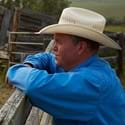Arriving in Alberta, Canada, in 1928, the Hughes family established their 2,200-hectare ranch near Longview in 1950. Nearly 70 years on, the reins are in good hands with Stephen who, in partnership with his father, has aligned his approach with a vision for more sustainable, viable beef production.
Stephen’s focus is on developing year-round grazing, a practice that he introduced to the ranch in 1996 with the aim of re-establishing the synergistic relationship between grassland and ruminant. This practice has dramatically reduced the need to make hay in the summer – as well as reduced time and effort to feed it out in winter – all of which has a beneficial impact on input costs.
This focus on range management has deepened the family’s appreciation for their environment in the foothills of the Rocky Mountains. Stephen and his three daughters are committed to protecting their local ecosystem and preserving this area for generations to come.
McDonalds Flagship Farmer Stephen Hughes is committed to working with nature rather than against it. Bringing together a community of people who share his desire to raise cattle in a more environmentally conscious way, he is helping to leave the land better than when he started.
Key areas of sustainable practice
A system of rotational grazing not only allows pastures time to recover, it also improves soil quality. By moving cattle every three to seven days, grasses are given time to regrow, increasing the carbon sequestration potential of the soil.
Stephen has made a commitment to help protect the ecologically significant areas of the ranch by having been granted an easement through the Natural Areas Conservation Program (NACP), which is administered by the Nature Conservation of Canada (NCC). This easement protects the native grasslands from any type of future development, ensuring they continue to sequester carbon.
A successful rotational grazing system needs a good water infrastructure. With this in mind, Stephen has invested in water wells, solar pumps and water troughs to ensure animals have easy access to clean water.
The Hughes’s ranch contains several ecologically significant grasslands. To ensure these areas are protected from future development, a land easement has been granted under a program run by the Natural Areas Conservation Program (NACP).
Through a system of rotational grazing, cattle are moved every three to seven days during the growing season. This allows pastures time to recover, improves carbon sequestration and encourages a more diverse range of grasses to grow.
Chinook Ranch participated in the Verified Sustainable Beef pilot project conducted by McDonald’s Canada. The robust assessment and on-ranch audit gave the ranch the opportunity to be verified as a sustainable operation.
The ranch is also engaged in Verified Beef Production Plus, the mechanism to verify sustainable practices for the Canadian Roundtable for Sustainable Beef. The mechanism also aims to maintain and promote the quality and safety of beef produced in Canada.
Stephen believes future generations should see sustainability as normal practice. He is actively engaged with 4-H, a nonprofit youth organization that works with young people to develop life skills, as well as leadership, respect and compassion. As a 4-H Beef Club leader, Stephen works to promote sustainability through workshops and debates.
Each year, the 4-H Beef Club holds a livestock auction and sale, with all money raised going toward the maternity unity of their local hospital. Promoting this type of engagement via 4-H teaches young people about the importance of being an active contributor to their community.
The year-round grazing technique that is utilized on the ranch benefits the Hughes financially through reducing reliance on daily winter feed for cows. Expenditures on machinery, fuel and labor are also saved.
Stephen’s integrated ranch management approach helps ensure that the ranch thrives while working within the boundaries of Mother Nature. For example, late spring calving takes advantage of warmer temperatures and avoids the colder months where the low temperatures are harmful to calves. Nutritional requirements are matched to pasture-peak nutrition to benefit cow fertility and breeding. Stephen selects cattle genetics that fit the system, such as easy calving, high maternal traits and the ability to forage and graze. All are critical elements to mimic a pattern perfected over millennia.
Herd health is prioritized, and any death losses are sent to the veterinary school at the University of Calgary, Alberta, for postmortem, providing the farm with information and giving veterinary students an opportunity to learn.
The Hughes have focused on low-stress handling techniques, such as understanding cattle flight zones and points of balance. This has made working with the cattle easier and reduced the stress for animals and people. Selecting polled genetics avoids the need to disbud calves, while analgesia is used during castration to relieve pain.
Learn more about Stephen Hughes’ story at Chinook Ranch
Explore the case study, where you’ll find additional details on how Chinook Ranch has aligned with the Flagship Farmers Program’s key areas of sustainable practices, what external research reveals about the producer's actions and how improved sustainability is benefiting them.

“Trust yourself and don’t be afraid to implement changes. Challenge everyone that says ‘but we’ve always done it this way’.”






